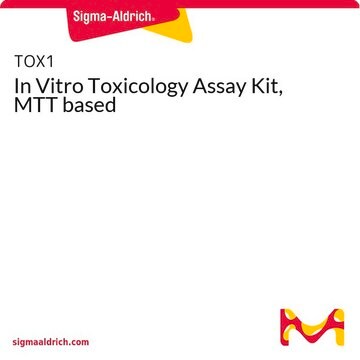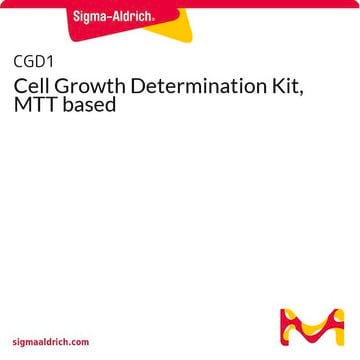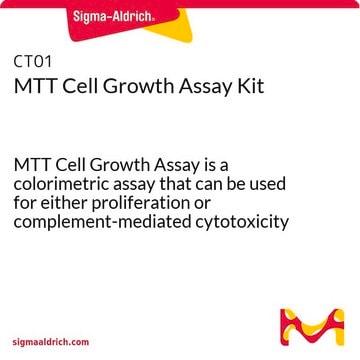At physiological pH, phenol red strongly absorbs in the same wavelength range as the MTT assay’s readout product. Washing cells thoroughly to remove the media and phenol red minimizes this interference.
M5655
Bleu de thiazol (thiazolyl blue tetrazolium bromide)
powder, BioReagent, suitable for cell culture, suitable for insect cell culture, ≥97.5% (HPLC)
Synonyme(s) :
Bromure de 3-(4,5-diméthyl-2-thiazolyl)-2,5-diphényl-2H-tétrazolium, Bromure de méthylthiazolyldiphényl-tétrazolium, MTT
Sélectionner une taille de conditionnement
32,80 €
Sélectionner une taille de conditionnement
About This Item
32,80 €
Produits recommandés
Gamme de produits
BioReagent
Niveau de qualité
Essai
≥97.5% (HPLC)
Forme
powder
Technique(s)
cell culture | insect: suitable
cell culture | mammalian: suitable
Pf
195 °C (dec.) (lit.)
Solubilité
H2O: 5 mg/mL
Température de stockage
2-8°C
Chaîne SMILES
[Br-].Cc1nc(sc1C)-[n+]2nc(nn2-c3ccccc3)-c4ccccc4
InChI
1S/C18H16N5S.BrH/c1-13-14(2)24-18(19-13)23-21-17(15-9-5-3-6-10-15)20-22(23)16-11-7-4-8-12-16;/h3-12H,1-2H3;1H/q+1;/p-1
Clé InChI
AZKSAVLVSZKNRD-UHFFFAOYSA-M
Vous recherchez des produits similaires ? Visite Guide de comparaison des produits
Catégories apparentées
Application
Produit(s) apparenté(s)
Mention d'avertissement
Warning
Mentions de danger
Conseils de prudence
Classification des risques
Eye Irrit. 2 - Muta. 2 - Skin Irrit. 2 - STOT SE 3
Organes cibles
Respiratory system
Code de la classe de stockage
11 - Combustible Solids
Classe de danger pour l'eau (WGK)
WGK 3
Point d'éclair (°F)
Not applicable
Point d'éclair (°C)
Not applicable
Équipement de protection individuelle
Eyeshields, Gloves, type N95 (US)
Faites votre choix parmi les versions les plus récentes :
Déjà en possession de ce produit ?
Retrouvez la documentation relative aux produits que vous avez récemment achetés dans la Bibliothèque de documents.
Les clients ont également consulté
-
Why can't a medium with phenol red be used? Is it because it interferes with MTT assay results? If after incubation with MTT, cells are washed with PBS and DMSO is used to dissolve the crystals, does this still apply?
1 answer-
Helpful?
-
-
Should I prepare fresh for each use or I directly resuspend in 20 ml of water (for the 100 mg bottle) and store? In the latter case, how can I store the solution?
1 answer-
The solution may be filtered through a 0.2 μm filter and stored at 2-8°C for frequent use or stored in aliquots and frozen at -20°C for extended periods.
Helpful?
-
-
What's the difference between M5655 and M2003?
1 answer-
Product M5655 is Thiazolyl Blue Tetrazolium Bromide and Product M2003 is Thiazolyl blue formazan.
MTT (Cat. no. M5655) is used in the measurement of cell proliferation. MTT produces a yellowish solution that is converted to dark blue, water-insoluble MTT formazan (Product M2003) by mitochondrial dehydrogenases of living cells. The blue MTT formazan crystals are solubilized with acidified isopropanol and the intensity is measured colorimetrically at 570 nm. Thus, the amount of blue formazan is proportional to the number of viable cells. For more information regarding this particular assay, we do offer an assay kit, TOX1, which is based on this principle: https://www.sigmaaldrich.com/product/sigma/tox1.
Helpful?
-
-
What is the Department of Transportation shipping information for this product?
1 answer-
Transportation information can be found in Section 14 of the product's (M)SDS.To access the shipping information for this material, use the link on the product detail page for the product.
Helpful?
-
-
What type of multi-well plate should be used for the Thiazolyl Blue Tetrazolium Bromide (MTT) assay?
1 answer-
It is recommended that flat bottom multi-well plates be used for the MTT assay. The use of tissue culture treated plates is only important if necessary for good cell growth. If cells are grown in larger plates, the supernatant after cell lysis can be transferred to a 96 well plate for reading.
Helpful?
-
-
What can be used to make a solution of Thiazolyl Blue Tetrazolium Bromide (MTT)?
1 answer-
We test the solubility of MTT in water at a concentration of 5 mg/mL. For the MTT viability assay, we dissolve Product No. M5655 at a concentration of 5 mg/ml in RPMI-1640 without phenol red. This medium is available as a powder (Product No.R8755) or liquid (Product No. R7509). MTT can be solubilized in any culture media or balanced salt solution that does not contain phenol red as a pH indicator.
Helpful?
-
-
Is the MTT assay quantitative?
1 answer-
The MTT asay is a method to assess cell viability. This assay is a semiquantitative assay. The assay is used to compare the viability changes in treated cells to untreated cells. The absorbance is indicative of the cell number. The higher the absorbance, the greater the number of viable cells present. Most researchers compare the absorbance of the two samples as a ratio (ABS treated cells/ABS untreated cells) to get a fold increase/decrease in cell number.
Helpful?
-
-
How can Thiazolyl Blue Tetrazolium Bromide be used for staining dehydrogenase in tissue sections?
1 answer-
Products M2128 or M5655, Thiazolyl Blue Tetrazolium Bromide can be used for staining dehydrogenase in tissue sections. See the method below. Reagent PreparationMTT (2 mg/ml distilled water) 2.5 ml0.2 M Tris buffer, pH 7.4 2.5 ml0.5 M cobalt chloride 0.5 ml0.05 M magnesium chloride 1.0 mlDistilled water 2.5 mlThe pH of this solution is adjusted to 7.0 if necessary. Aliquot and store at -20°C until required. Sample PreparationCut cytostat sections at 5 to 7 microns. Do not fix. Method:1. Incubate sections in appropriate incubation solution at 37°C for 30-60 minutes.2. Transfer sections to 15% formol saline, 15 minutes.3. Wash in distilled water4. Counterstain in 2% methyl green if required.5. Wash in distilled water.6. Mount in glycerin Jelly. ResultsEnzyme: Black formazan deposits with MTT Source: Bancroft and Gamble, Theory and Practice of Histological Techniques, Fifth Edition. Churchill Livingstone, London, 2002, page 610.
Helpful?
-
-
Why is a reference wavelength used for data analysis of Thiazolyl Blue Tetrazolium Bromide (MTT)?
1 answer-
The reference wavelength (630-690 nm) is used to adjust for the optical variation in the wells of the plate. It also corrects for dust and fingerprints that can be present. The assay is read at 570 nm. The reference wavelength needs to be far enough away from the assay wavelength so as not to affect those values.
Helpful?
-
-
What can be used to solubilize MTT formazan (the product of the Thiazolyl Blue Tetrazolium Bromide - MTT reaction)?
1 answer-
Mitochondrial dehydrogenases of viable cells cleave the tetrazolium ring of the MTT, yielding purple MTT formazan crystals. These crystals are not soluble in aqueous solutions; they may be dissolved in acidified isopropanol (0.1 N HCl in anhydrous isopropanol). If this does not lyse the cells, Triton X-100 can be added to the acidified isopropanol. A typical working concentration is 10% Triton X-100 (i.e., 1 volume of 100% Triton X-100 + 9 volumes of acidified isopropanol).
Helpful?
-
Active Filters
Notre équipe de scientifiques dispose d'une expérience dans tous les secteurs de la recherche, notamment en sciences de la vie, science des matériaux, synthèse chimique, chromatographie, analyse et dans de nombreux autres domaines..
Contacter notre Service technique














